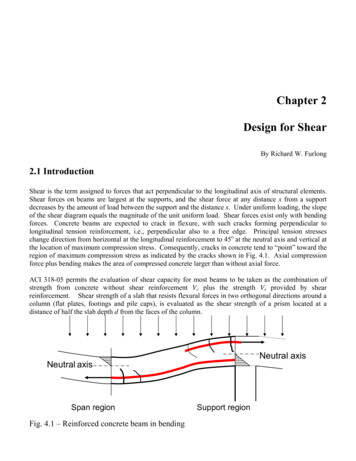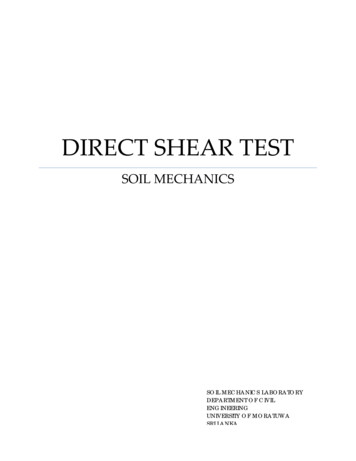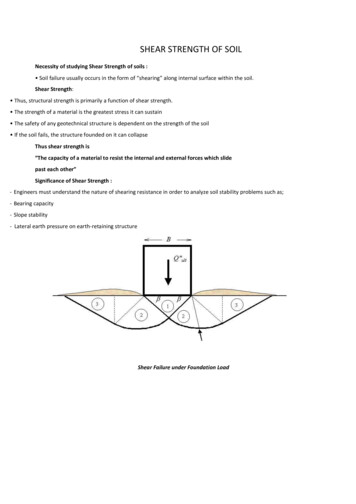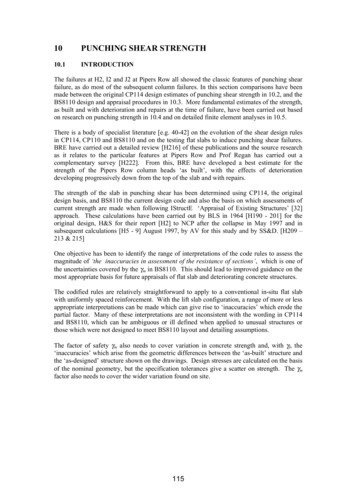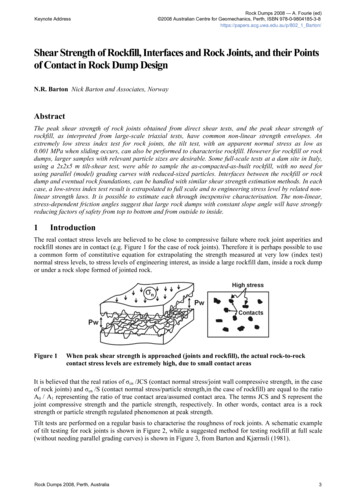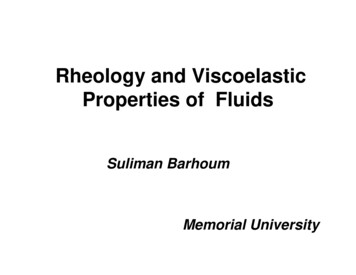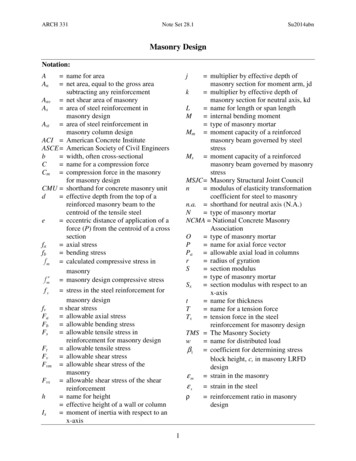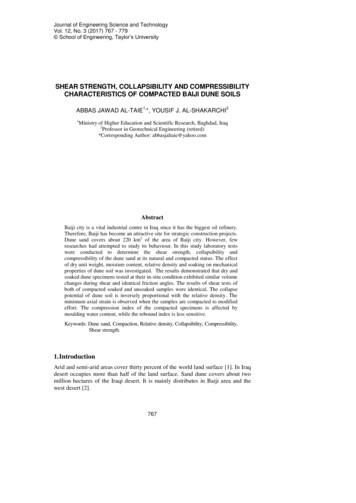
Transcription
Journal of Engineering Science and TechnologyVol. 12, No. 3 (2017) 767 - 779 School of Engineering, Taylor’s UniversitySHEAR STRENGTH, COLLAPSIBILITY AND COMPRESSIBILITYCHARACTERISTICS OF COMPACTED BAIJI DUNE SOILS1,ABBAS JAWAD AL-TAIE *, YOUSIF J. AL-SHAKARCHI21Ministry of Higher Education and Scientific Research, Baghdad, Iraq2Professor in Geotechnical Engineering (retired)*Corresponding Author: abbasjaltaie@yahoo.comAbstractBaiji city is a vital industrial centre in Iraq since it has the biggest oil refinery.Therefore, Baiji has become an attractive site for strategic construction projects.Dune sand covers about 220 km2 of the area of Baiji city. However, fewresearches had attempted to study its behaviour. In this study laboratory testswere conducted to determine the shear strength, collapsibility andcompressibility of the dune sand at its natural and compacted status. The effectof dry unit weight, moisture content, relative density and soaking on mechanicalproperties of dune soil was investigated. The results demonstrated that dry andsoaked dune specimens tested at their in-situ condition exhibited similar volumechanges during shear and identical friction angles. The results of shear tests ofboth of compacted soaked and unsoaked samples were identical. The collapsepotential of dune soil is inversely proportional with the relative density. Theminimum axial strain is observed when the samples are compacted to modifiedeffort. The compression index of the compacted specimens is affected bymoulding water content, while the rebound index is less sensitive.Keywords: Dune sand, Compaction, Relative density, Collapsibility, Compressibility,Shear strength.1. IntroductionArid and semi-arid areas cover thirty percent of the world land surface [1]. In Iraqdesert occupies more than half of the land surface. Sand dune covers about twomillion hectares of the Iraqi desert. It is mainly distributes in Baiji area and thewest desert [2].767
768A. J. Al-Taie and Y. J. Al-ShakarchiNomenclaturesCcCrDreoPcCompression indexRebound indexRelative density, percentageInitial void ratioPreconsolidation pressure, kN/m2Greek Symbols ecChange in void ratio resulting from saturationAxial strain at applied pressure (800 kPa), percentage( a) 800ϕAngle of internal friction, deg.Dry unit weight, kN/m3 dMaximum dry unit weight, kN/m3 dmaxMinimum dry unit weight, kN/m3 dminMoisture content, , percentage AbbreviationsCPOMCSPCollapse Potential, percentageOptimum Moisture Content, percentagePoorly graded sandMany researchers studied patterns, geomorphology, geographic distribution andgeologic characteristics of Iraqi sand dune [3-7]. Other researchers investigatedorigin, nature, physical and mineralogical properties of dune [8-12].Sedimentology, pedological and hydrological aspects of Iraqi dune wasextensively studied [3, 4, 13]. The movement, extension, reclamation, fixation,controlling and stabilization of this soil are well documented in the literature [12,14-16]. Some studies were directed to study environmental impacts andgeological hazards of dune [17-19]. However, there is scarcity in the specializedliterature concerning geotechnical characteristics of Iraqi dune soil.Dune soil could be used in construction when compacted or mixed withadditives [20-21]. Therefore, there is a need to conduct an investigation to studythe relevant engineering properties of Iraqi dune soil.In this study, laboratory tests were conducted to determine the shear strength,collapsibility and compressibility of the dune sand samples obtained from BaijiCity. The effect of dry unit weight, moisture content, relative density and soakingon mechanical properties of dune soil was studied.2. Geology and Geological Hazards of Baiji Sand DuneBaiji city locates south of Makhul Mountain and west of Tigris River and bordersby Wadi Tharthar on the west. The sand dune in Baiji area covers about (220)km2 to the north and west, and extends to the south of the city, Fig. 1. Most of thedune sand is derived from the older formations such as Injana Formation (mainlycontained from Sandstone) and Quaternary fans and terraces (mainly composedfrom fluvial, alluvial, sandy gravel deposits), the presence of sand dune as sheetJournal of Engineering Science and TechnologyMarch 2017, Vol. 12(3)
Shear Strength, Collapsibility and Compressibility Characteristics of . . . . 769of sand of Pleistocene and recent ages in the area of Baiji as a part ofMesopotamian plain [12, 22].Sand dune in Baiji area causes many problems, such as accumulation of themoved sand on the railway, roads, sand and dust storms caused pollution anddesertification. Baiji sand dune consists of three main parts. They are barchansbelt, fixed dune and scattered patches. Barchans belt lies few kilometres to thenorthwest from Baiji city, while fixed dune belt locates around the south of Baijiand scattered patches of dune lies to west of the main belts [8, 23].Fig. 1. Geographical distribution of sand dune in Iraq [18].3. Samples Preparation3.1. Correlation with dune morphology (Natural soil)In general, dune sand in nature found dry, cohesionless and with low relativedensity. Loose sand is irregularly distributed on the windward slope of dune aswell as throughout the leeward slope. Denser sand formed on the upper portion ofthe windward slope of dune just back from the crest. The transition from looseJournal of Engineering Science and TechnologyMarch 2017, Vol. 12(3)
770A. J. Al-Taie and Y. J. Al-Shakarchistate to relatively dense state may be quite abrupt [24, 25]. The deposition of sandin the loosest form with relative density of less than 20% can be spreaded near thecrest. At the deeper levels, the sand is compacted under the overburden pressure,therefore it is slightly more stable [25]. If the soil of dune is used in its naturalstate, it is necessary to determine the engineering properties of dune soil. Toachieve this aim the following procedure was adopted in preparing the samplesfor the oedometer and shear tests:First, minimum ( dmin) and maximum ( dmax) dry unit weights were determined.Then, five relative densities (Dr) were adopted to represent the field relativedensities. They are listed in Table 1. The formula used for the calculation of dryunit weight ( d) is: d ( d max d min )( dmax Dr ( d max d min ))(1)The oven dry soil required for a specific dry unit weight was prepared bydropping grains from a suitable height into the ring of the oedometer or the box ofthe direct shear device. It is important to note that both of the ring and the box isfitted in its device before the placing of the soil. Also, the soil must fill the ring orthe box to achieve the specified dry unit weight, otherwise, the sample is rejected.For shear and oedometer tests, two identical groups of natural soil were papered.Each group consists of five sets of four similar specimens. These specimens wereprepared according to the procedure outlined above. The soil in the first groupwas tested at their dry in-situ condition. While in the second group the soil wassoaked in water to about two hours then tested.Table 1. Adopted relative densities [26].D r, %States0-20Very loose20-40Loose40-60Medium60-80Dense80-100Very dense3.2. Compacted specimensSamples have been prepared at different moisture content and compacted to thecorresponding dry unit weights. The soil was compacted using the standard andmodified Proctor procedures. The compacted samples were extracted fromcompaction mold by pushing the test ring or box (of oedometer or direct shear)carefully to the required thickness. Then, the faces were trimmed and leveled. Forshear and oedometer tests, two groups of specimens were compacted at optimummoisture content to the maximum dry densities obtained from standard andmodified Proctor tests. The soil in the first group was tested at its initialplacement condition (as compacted), while the second group was tested aftersoaking with water.4. Testing ProgramClassification tests were performed according to (ASTM D422), then minimumand maximum dry unit weight determination was fulfilled based on (ASTMD4254). Standard (ASTM D698) and modified (ASTM D1557) compaction testswere carried out to determine the moisture content-unit weight relationship.Journal of Engineering Science and TechnologyMarch 2017, Vol. 12(3)
Shear Strength, Collapsibility and Compressibility Characteristics of . . . . 771Two series of shear tests were conducted using the direct shear apparatus(ASTM D3080). A calibrated proving rings of (200 kg) and (300 kg) capacity and(0.002 mm) precision dial gauge for vertical deformation reading were used,while for horizontal deformation a (0.01 mm) gauge was used. The rate of strainwas (1.2 mm/min). In the first series, five sets of four samples each was preparedusing the preparation procedure outlined in section (3.1). The samples were testedat dry condition. Identical samples were prepared and tested after soaking inwater. In the other series, two groups of specimens were compacted to differentmoisture contents and dry densities. They were prepared with a size of (60x60x20mm) using the preparation procedure outlined in section (3.1). The first group wastested with no addition of water, while the other group was soaked in water andthen tested. All specimens were tested using normal pressure of 82.5, 165, 247.5and 330 kPa for each set. The time of soaking in water was about two hours.Compression and collapse tests were conducted using the standard frontloading oedometer (the sample size used was 76 mm in diameter by 19 mm inheight).The double oedometer test was carried out according to the procedure ofJennings and Knight [27]. This procedure developed for assessing the response ofa soil to wetting and loading at different stress levels. In this procedure twooedometer tests are carried out on identical samples, one being tested at its naturalmoisture content, whilst the other is tested under saturated condition, the sameloading sequence being used in both cases. Samples were loaded progressively asin the consolidation test.5. Results of Physical, Relative Density and Compaction TestsAccording to unified soil classification system (ASTM D 2487) the soil of sanddune can be classified as poorly graded sand (SP). The specific gravity of this soilis 2.7. The values of γdmax and γdmin are 16.53 kN/m3 and 14.30 kN/m3respectively. The optimum moisture content (OMC) and the maximum unitweight (γdmax) for standard and modified compaction tests are summarized inTable 2. It is noted that γdmax of dune sand is obtained when the soil is compactedusing modified compaction test. When sand is air dried by using vibratorycompaction, high unit weight was achieved than standard proctor compaction test;however, the difference is small.Table 2. Summary of relative density and compaction tests.Soil PropertyStandard CompactionModified Compactionγdmax and γdmin for dry soilOMC (%)15.0011.50-γdmax (kN/m3)16.4217.5516.53γdmin , (kN/m3)14.305.1. Compression tests resultThe compression tests results are shown in Table 3 and Fig. 2. It is clear to notethat the (as compacted) specimens are less compressible than the soakedspecimens. They have low compression index (Cc), rebound index (Cr) andpreconsolidation pressure (Pc). Furthermore, Cc was decreased about when thecompaction effort increased.Journal of Engineering Science and TechnologyMarch 2017, Vol. 12(3)
772A. J. Al-Taie and Y. J. Al-ShakarchiTable 3. Results of compression test.Compactionγd, 4417.50ω%eoPe, kPaAs Compacted Specimens14.50.6426811.50.57970Soaked 70.0030.0560.0440.0170.016The effect of compaction moisture content on compressibility characteristicsis clearly illustrated in Fig. 2. The results indicate that when the moisture contentincreased from dry side to wet side of the optimum, Cc increases from 0.035 to0.050. This represents 40 % increase in compressibility due to the increase inmoisture content. However, this is not significant since the initial compressibilityis very low. Re-examination of Fig. 2 reveals that the rebound curves of dune soilare relatively flat with a very low rebound index from 0.0015 to 0.0016, andmoisture content has low effect on the magnitude of Cr.(a) Specimens compacted withdifferent compaction efforts(b) Specimens compacted withdifferent moisture contentsFig. 2. Compression tests result.5.2. Results of collapse tests for natural specimensTable 4 summaries the result of collapse tests using double oedometer procedure.The value of deformation at any stress level at which the soil get saturated isobtained from the difference between the compression curves. Typical resultsfrom double oedometer test for loose and dense specimens are shown in Fig. 3.The collapse potential can be determined at any required stress level. Based onJennings and Knight [27] the collapse potential was calculated using thefollowing equation:CP ec / (l eo)(2)Where ( ec ) is the change in void ratio resulting from saturation and (eo) is theinitial void ratio. Figure 3 is indicated that the collapse potential (CP) for eachJournal of Engineering Science and TechnologyMarch 2017, Vol. 12(3)
Shear Strength, Collapsibility and Compressibility Characteristics of . . . . 773load increment, and the final strain (at 800 kPa). According to the ASTM D53331, the collapsibility of the natural dune sand can be classified as slight tomoderate. The CP of this soil increases with the increase of soaking pressure.Table 4. Results of collapse test using double oedometer procedure.AppliedStress kPa50100200unsoakedsoakedPropertyCP, %( a)800,%Very loose2.782.882.903.516.20(a) Stress-strain curvesRelative DensitiesLoose Medium .775.452.454.74Very dense1.381.641.852.574.50(b) Collapse potential- Dr(c) Axial strain vs. DrFig. 3. Collapse tests results from double oedometer procedure.Journal of Engineering Science and TechnologyMarch 2017, Vol. 12(3)
774A. J. Al-Taie and Y. J. Al-ShakarchiFigure 3 shows the effect of vertical pressure and relative density (Dr) on CPand the axial strain of the dry and soaked dune samples. As it is expected,increasing of relative density resulted in decreasing in collapse potential. It isattributed to the reduction in void ratio of the specimens with increasing Dr.However; a considerable increase in the axial strain due to soaking (about 55%)can be seen from Fig. 3. The axial strain is decreased with increasing the relativedensity as it shown in Fig. 3.5.3. Results of collapse tests for compacted specimensFigure 4 shows the results. The results reveal that the behaviour of the dunesamples compacted with Proctor efforts is resemble the behaviour of the naturalspecimen (vibratory compaction), where small collapse potential was recorded inboth cases. A comparison between the axial strain values (at applied pressure of800 kPa) of the natural dense specimens and compacted specimens at standardand modified efforts is shown in Fig. 4. It is noted that the minimum axial strainof dune sand is obtained when the soil is compacted at modified compactioneffort. Consequently, dry sand specimens prepared by vibratory compactionshows low axial strain than specimens prepared at standard proctor compactioneffort. Furthermore, the difference between axial strains of specimens compactedwith vibratory and modified compaction is minimal.(a) Axial Strain versus appliedpressure(b) Axial strain for differentcompaction statesFig. 4. Results of collapse tests for compacted specimens.5.4. Direct shear tests for natural specimensThe stress-strain curves for dry and soaked specimens prepared at loose and densestates are shown in Fig. 5. It is demonstrated that these curves behave similarityfor granular soil. The shearing stress at loose state is increase with increasedisplacement until failure, unlike the shear stress of dense sand that increasesfrom zero to a peak value and then gradually decreases to an ultimate or residualvalue. Dry and soaked specimens tested at their dry in-situ condition exhibitedJournal of Engineering Science and TechnologyMarch 2017, Vol. 12(3)
Shear Strength, Collapsibility and Compressibility Characteristics of . . . . 775similar volume changes during shear. The volume of the dense specimendecreases (up to 3 mm of horizontal displacement) and dilates (about 6 mm ofhorizontal displacement). While the volume of loose specimen decrease withincrease horizontal displacement.The strength envelopes for sand tested are given in Fig. 6. The cohesionparameter is varied from (0 to 10) kPa for dune soil tested at dry and soakedconditions. Moreover, soaked and unsoaked specimens showed slightly identicalfriction angles for both loose and dense specimens ranged from (35o to 36o) forloose state and (41o to 42o) for dense state. The decrease in the coefficient offriction (tan ϕ) for dune sand due to soaking fall between (0 to 6) %.The angle of internal friction correlated well with the relative density asshown in Fig. 6. The angle of repose was determined for dune soil. It is foundthat, the value of the angle of repose is equal to 31 o. It is interesting to note thatthe angle of internal friction of the dune soil at loose state is greater than that ofthe angle of repose. It is because the slope of slip face of dune will have an angleof repose varies from 30 o to 35 o, depending on the type of material, relativedensity, particle shape and surface roughness, [26, 28].(a) Dense soil(b) Loose soilFig. 5. Direct shear test result.Journal of Engineering Science and TechnologyMarch 2017, Vol. 12(3)
776A. J. Al-Taie and Y. J. Al-Shakarchi(b) ϕ vs Dr(a) Mohr envelopsFig. 6. Mohr envelops, ϕ and Dr of natural dune sand.5.5. Direct shear tests for compacted specimensFigure 7 gives a summary of direct shear test results for compacted soil. It can beseen that, the results of shear tests on soaked samples are mostly similar withunsoaked. The angle of internal friction decreases by 1 to 2 degrees due tosoaking. Moreover, the apparent cohesion is diminished when the soil is soaked.(a) Standard compaction(b) Modified compactionFig. 7. Direct shear test result compacted dune sand.Journal of Engineering Science and TechnologyMarch 2017, Vol. 12(3)
Shear Strength, Collapsibility and Compressibility Characteristics of . . . . 777The general behaviour of the compacted sand during direct shear tests isapproximately similar to that of the natural dense specimens, whereas a peakedstress-strains curves reveal an initial volume decrease followed by an increase inthe thickness of the specimen prior to failure at peak stress. Furthermore, theangle of internal friction for the soil in both cases fills in the range between (40 to43) degree.6. ConclusionsStrength, collapsibility and compressibility tests were carried out on dune soilsobtained from Baiji city. Tests were performed on natural and compactedspecimens. Based on the results the following conclusions are made: The compression index of the compacted dune soil increase with increase ofmolding water content. The change in moisture content merely effect on themagnitude of rebound index. Furthermore, when the compaction effortincreased from standard to modified compression index value of dune soilwas occurred by about 21%. The collapse potential and the axial strain of dune soil decreases withdecrease of soaking pressure and with increase the relative density. Theminimum axial strain got when the soil is compacted using modifiedcompaction test. Air dried specimen shows low axial strain rather thanspecimens compacted at standard proctor effort. Dry and soaked dune specimens tested at in-situ condition exhibited similarvolume changes during shear and almost identical friction angle. The angle ofinternal friction increases with increases relative density. For compacted soil,the shear test on soaked samples is almost identical with unsoaked samples.The angle of internal friction decreases by 1 to 2 degrees due to soaking.Moreover, the apparent cohesion is diminished when the soil is soaked. Thegeneral behaviour of the compacted sand during shear test is approximatelysimilar to that of the natural dense specimens. Finally, the angle of internalfriction of dune sand at loose state is greater than that of the angle of repose.References1.2.3.4.5.Gratzfeld, J. (2003). Extractive industries in arid and semi-arid zones:Environmental planning and management. International Union forConservation of Nature, Gland, Switzerland and Cambridge, United Kingdom.Khadair, A.A. (1997). Stabilization of Nasiriya sand dunes by cement dust. M.Sc.Thesis. College of Engineering, University of Technology, Baghdad, Iraq.Al-Saadi, S.N. (1972). Geomorphology, sedimentology and origin of Baijidune field. Journal of the Geological Society of Iraq, 5, 179.Jawad, A.A.; and Al-Ani, R.A. (1983). Sedimentological andgeomorphological study of sand dunes in the Western Desert of Iraq. Journalof Arid Environments, 6(1), 13-32.Shaker, S.N. (1985). Geomorphology of the sand dunes to the region betweenKut-Diwaniyah,and Nasiriyah. M.Sc. Thesis. College of Science, BaghdadUniversity, Baghdad, Iraq.Journal of Engineering Science and TechnologyMarch 2017, Vol. 12(3)
A. J. Al-Taie and Y. J. Al-ShakarchiAl-Dabi, H.; Koch, M.; Al-Sarawi, M.; and El-Baz, F. (1997). Evolution ofsand dune patterns in space and time in north-western Kuwait using landsatimages. Journal of Arid Environments, 36(1), 15-24.Al-Hmedawy, H.D. (2008). Geomorphological study of Haur Al-Hammar andadjacent area southern Iraq using remote sensing data and GIS techniques.M.Sc. Thesis. College of Science. Baghdad University, Baghdad, Iraq.Al-Saadi, S.N. (1971). Geomorphology, sedimentology and origin of Baiji dunefield. M.Sc. Thesis. College of Science. Baghdad University, Baghdad, Iraq.Skoček, V; and Saadallah, A.A. (1972). Grain size distribution, carbonatecontent and heavy minerals in aeolian sands, southern desert, Iraq.Sedimentary Geology, 8(1), 29-46.Al Janabi, K.Z.; Ali, A.J.; Al-Taie, F.H.; and Jack, F.J. (1988). Origin andnature of sand dunes in the alluvial plain of southern Iraq. Journal of AridEnvironments, 14(1), 27-34.Shearzid, M.F. (1989). Wind deposits and its impact on the design of humansettlements. M.Sc. Thesis. College of Engineering, University of Technology,Baghdad, Iraq.Kadim, L.S.; Hussain, A.I.; and Salih, S.A. (2009). Study of nature, origin,movement and extension of sand dunes by using sedimentological aspectsand remote sensing techniques in Baiji area, north Iraq. Kirkuk UniversityJournal Scientific Studies, 4(2), 22-36.Buringh, P. (1960). Soils and soil conditions in Iraq. The Ministry ofAgriculture, Baghdad, Iraq.Dougremeji, J.; and Kaul, R.N. (1972). Sand dune reclamation in Iraq present status and future prospects. Annals of Arid Zone, 11(3-4), 133-144.Gati, F. (1984). Controlling sand dune encroachment in Iraq. DesertificationControl Bulletin, United Nations Environment Programme (UNEP), 11, 22-26.Al-Soud, M.S. (2000). Stabilization of Baiji sand dunes by petroleumresidues. M.Sc. Thesis. College of Engineering, University of Baghdad,Baghdad, Iraq.Al-Marsoumi, A.H.; and Al-Asadi, M.M. (2010). Dust storms and theirenvironmental impacts at the northwest part of Arabian Gulf. Iraqi Journal ofDesert Studies, 2(2), 43-53.Sissakian, V.K.; Abdul Ahad A.D.; and Hamid A.T. (2011). Geologicalhazards in iraq, classification and geographical distribution. Iraqi Bulletin ofGeology and Mining, 7(1), 1-28.Sissakian, V.K.; Al-Ansari, N.; and Knutsson, S. (2013). Sand and dust stormevents in Iraq. Natural Science, 5(10), 1084-1094.Al-Gunaiyan, K.A. (1998). Assessment of the geotechnical properties ofstabilized sand-marl mixtures for constructional purposes. M.Sc. Thesis.King Fahd University of Petroleum & Minerals Dhahran, Saudi Arabia.Albusoda, B.S.; and Hussein, R.S. (2013). Bearing capacity of eccentricallyloaded square foundation on compacted reinforced dune sand over gypseoussoil. Journal of Earth Sciences and Geotechnical Engineering, 3(4), 47-62.Aqrawi, A.A.; Dmas, J.; and Jassim, S.Z. (2006). Geology of Iraq. Dolin,Prague and Moravian Museum, Brno. Czech Republic, 185-192.Journal of Engineering Science and TechnologyMarch 2017, Vol. 12(3)
Shear Strength, Collapsibility and Compressibility Characteristics of . . . . 77923. Al-Taie, A.J.; Al-Shakarchi, Y.J.; and Mohammed, A.A. (2013).Investigation of geotechnical specifications of sand dune soil: a case studyaround Baiji in Iraq. IIUM Engineering Journal, 14(2), 121-132.24. Lee, D.-H.; Wu, J.-H.; Hsu, C.-C.; Huang J.-C.; and Tien Y.-M. (2009).Geotechnical investigations of sand dune beneath the fort Zeelandia Tainan.Taiwan Journal of Architecture, 67, 41-56.25. Gupta S.; and Sundaram R. (2001). Behavior of dune sands of the TharDesert under dynamic loading. Proceedings of the 4th International.Conferace on Recent Adanced. in Geotechnical Earthquake Engineering andSoil Dynamics. San Diego, California, USA, 26-31.26. Holtz, R.D.; Kovacs, W.D.; and Sheahanand T.C. (2010). An introduction togeotechnical engineering (2nd ed.). Prentice Hall.27. Jennings, J.E.; and Knight, K. (1975). A guide to construction on or withmaterials exhibiting additional settlement due to collapse of grain structure.Proceedings of the 6th Regional Conference for African Soil Mechanics andFoundation Engineering. Durban, South Africa, 99-105.28. Olufowobi, J.; Ogundoju, A.; Michael, B.; and Aderinlewo, O. (2014). Claysoil stabilisation using powdered glass. Journal of Engineering Science andTechnology, 9(5), 541-558.Journal of Engineering Science and TechnologyMarch 2017, Vol. 12(3)
Dune soil could be used in construction when compacted or mixed with additives [20-21]. Therefore, there is a need to conduct an investigation to study the relevant engineering properties of Iraqi dune soil. In this study, laboratory tests were conducted to determine the shear strength, collapsibility and compressibility of the dune sand .
